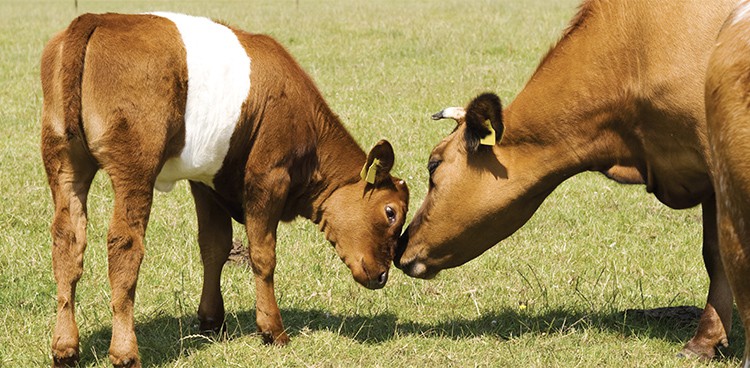
Dutch Belted cows, known in their homeland as Lakenvelder, are easy to spot in a crowd thanks to their signature white stripe (or “belt,” hence their English eponym) across their midsection. First brought to the United States in the early 1800s by the US consul of Holland, D. H. Haight, the striking animals captivated Americans via P. T. Barnum’s 1840 circus (they were exhibited as an exotic breed). Barnum soon realized that in addition to their dazzling appearance, the cows were also fantastic milkers—so he subsequently moved the bovines to his New York farm. Meanwhile, in the Netherlands, numbers of Dutch Belted cows dwindled due to excessive crossbreeding, and by 1950 only about five herds remained in the country.
Several decades later, the breed’s numbers in America plunged as well, the result of a decline in Dutch Belted breeders coupled with the USDA’s Dairy Termination Program of the 1980s (an attempt to reduce the national milk surplus by sending dairy herds to slaughter). Today the breed’s US population sits between 200 and 600—on the rise but still low enough to remain on The Livestock Conservancy‘s 2015 Conservation Priority List, a catalog of rare farm animal breeds nearing endangerment or extinction. However, Dutch Belted cows have not seen the same resurgence in their homeland. In fact, American cattle are considered truer to the original genotype than those currently in the Netherlands—the United States has even supplied Holland with genetic material from American Dutch Belted bulls to improve their breed.
The Dutch Belted Cattle Association of America is growing stronger, too. Though previously inactive, the organization is now fully operational and is working hard to improve the breed’s presence in the United States. And since Dutch Belteds live longer than other dairy cows—with longer milking and reproductive abilities to match—it’s not hard to see why.
Appearance and Temperament
Dutch Belted cows can be black or dark red but always have an iconic white belt. The animals average around 1,000 pounds in weight and 40 inches in height—quite a bit smaller than Holstein cattle, a fellow dairy breed. But what they lack in size they certainly make up for in character, says Molly Glasgow, co-owner of The Grey Barn and Farm in Chilmark, Mass. “They have real personalities,” she says. “They are very curious. But there’s always a leader … always a girl in charge of the herd.” Sam Canonica, co-owner of Manning Hill Farm in Winchester, N.H., agrees: “They are almost a little too smart … almost crafty,” he says. “[But] I wouldn’t have any other breed of cow.”
Milk and Cheese
Thanks to smaller-than-average fat globules, Dutch Belted cow milk has a smooth mouthfeel and is easy to digest. “It’s a more pure white milk than other breeds,” says Kristine Haag, secretary for the Dutch Belted Cattle Association of America. It’s what P. T. Barnum found so special about the cows back in 1840—the milk seemed destined for a cup. “It’s a really good drinking milk,” Canonica says. “It’s so sweet, and the texture is just different from any other [cow’s] milk.” Dutch Belted milk makes for great cheese, too: The smaller fat globules mean more moisture retention, which gives wheels a velvety, creamy texture.
Dutch Belted cows produce an average of 35 to 40 pounds (about 5 gallons) of milk per day and do so well into their teenage years. They also milk for longer than average after each calving, notes Haag: “Some of the other [breeds] will go for nine months or so. A Dutch Belted will milk [one to two months] longer.” Glasgow also loves the breed for its impressive milking abilities: “[Holstein cattle] are like supermodels, you know. They’re only good for a couple years.” Longevity, it seems, is a hallmark of Dutch Belted cattle—let’s hope that characteristic rubs off on the breed’s existence itself.



